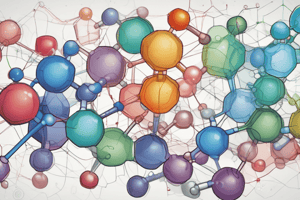Podcast
Questions and Answers
What elements are commonly found in heterocyclic compound rings?
What elements are commonly found in heterocyclic compound rings?
- Carbon and nitrogen only
- Carbon, nitrogen, and halogens
- Carbon and another element, such as nitrogen, oxygen, or sulfur (correct)
- Carbon, oxygen, and phosphorous
Which of the following correctly describes the parent heterocyclic compound naming?
Which of the following correctly describes the parent heterocyclic compound naming?
- The name is determined by the size of the ring and the heteroatom present (correct)
- The name is arbitrary and does not follow specific rules
- The name is based on the presence of multiple heteroatoms
- The name is based solely on the number of carbon atoms
Which heterocyclic compound contains two nitrogen atoms in its structure?
Which heterocyclic compound contains two nitrogen atoms in its structure?
- Pyridine
- Pyrimidine (correct)
- Furan
- Purine
What is the primary consideration for numbering the atoms in a heterocyclic ring?
What is the primary consideration for numbering the atoms in a heterocyclic ring?
Which of the following compounds is a fused ring system?
Which of the following compounds is a fused ring system?
Which statement about thiophene is true?
Which statement about thiophene is true?
Which of the following is true about pyrrole?
Which of the following is true about pyrrole?
The heterocyclic compound pyridine can be characterized as?
The heterocyclic compound pyridine can be characterized as?
Flashcards
Heterocyclic compounds
Heterocyclic compounds
Cyclic compounds containing at least two different elements in their ring structure, often carbon and nitrogen, oxygen, or sulfur.
Basic nomenclature of heterocyclic compounds
Basic nomenclature of heterocyclic compounds
The basic naming system for heterocyclic compounds, using prefixes like "pyrrole" and "furan" based on ring size and heteroatom.
Numbering heterocyclic rings
Numbering heterocyclic rings
A method for naming complex heterocyclic compounds where the ring atoms are numbered to prioritize the heteroatom and any substituents.
Pyrrole
Pyrrole
A five-membered aromatic heterocycle containing one nitrogen atom, known for its high aromaticity and stability.
Signup and view all the flashcards
Pyridine
Pyridine
A six-membered aromatic heterocycle containing one nitrogen atom, similar in structure to benzene.
Signup and view all the flashcards
Furan
Furan
A five-membered aromatic heterocycle containing one oxygen atom, with physical and chemical properties influenced by the presence of oxygen.
Signup and view all the flashcards
Thiophene
Thiophene
A five-membered aromatic heterocycle containing one sulfur atom. The sulfur atom alters the compound's chemical reactivity.
Signup and view all the flashcards
Fused ring systems
Fused ring systems
Systems formed when two or more rings share atoms. Nomenclature incorporates numbering of both rings and substituents.
Signup and view all the flashcardsStudy Notes
Introduction to Heterocyclic Compounds
- Heterocyclic compounds are cyclic compounds containing at least two different elements in their ring structure. Carbon and another element (nitrogen, oxygen, or sulfur) frequently form these rings.
- Many biologically significant molecules (amino acids, vitamins, hormones) contain heterocyclic rings.
Nomenclature Principles
-
Basic nomenclature:
- The parent heterocyclic ring name is determined by ring size and the heteroatom.
- Common prefixes: Azetidine (4-membered ring with nitrogen), Pyrrolidine (5-membered ring with nitrogen), Piperidine (6-membered ring with nitrogen), Pyrrole (5-membered ring with nitrogen), Furan (5-membered ring with oxygen), Thiophene (5-membered ring with sulfur).
-
Numbering:
- Ring atoms are numbered to give the heteroatom the lowest possible number.
- Numbering starts at the point of highest priority substitution.
- Substituents are named and numbered sequentially.
-
Specific examples:
- Pyridine: A 6-membered aromatic heterocycle with nitrogen. Substituents are named and numbered.
- Pyrimidine: A 6-membered aromatic heterocycle with two nitrogens. Substituents are named and numbered.
- Purine: A fused double ring with two nitrogens; a crucial component of DNA. Substitution numbering is essential.
Common Heterocyclic Rings
- Pyrrole: A five-membered aromatic heterocycle with one nitrogen atom. Its high aromaticity contributes to stability.
- Pyridine: A six-membered aromatic heterocycle with one nitrogen atom. Structurally related to benzene.
- Furan: A five-membered aromatic heterocycle with one oxygen atom. Oxygen's presence influences physical and chemical properties.
- Thiophene: A five-membered aromatic heterocycle with one sulfur atom. Sulfur alters reactivity compared to carbon-only rings.
Naming Complex Heterocycles
- Fused Rings: Two or more rings sharing common atoms form a fused ring system. Nomenclature reflects this.
- Naming fused rings: Numbering logically incorporates ring and substituent numbering.
Other Key Considerations
- Aromatic vs. Non-aromatic: Pi electron conjugation affects aromaticity and thus properties.
- Reactivity: The heteroatom's nature significantly impacts compound reactivity. Examples include pyridine nitrogen's electron acceptance and furan oxygen's nucleophilicity.
- Biological significance: Heterocyclic rings are present in many biologically active molecules; understanding their structures and properties is vital in drug design and biochemistry.
Studying That Suits You
Use AI to generate personalized quizzes and flashcards to suit your learning preferences.




